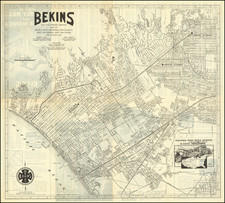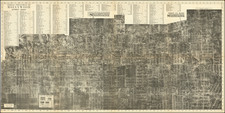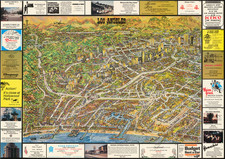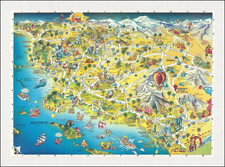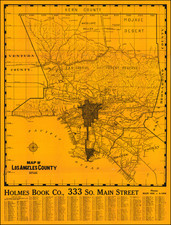Runnymede Colony Estates -- D.E. McKenzie Copy
Detailed early map and promotional brochure the Runnymede Colony in the San Fernando Valley, published for the Runnymede Sales Company of Irrigated, Intensively Cultivated One Acre Estates.
Highlighting the two Runnymede Colonies in green, the map locates the early Electric and Steam railroad lines, towns, post offices and roads in San Fernando Valley, at the beginning of its first major real estate boom. Several proposed street car lines are also shown, along with the Proposed Mullholland Skyline Drive.
Some of the early towns listed have long since been absorbed by other towns, including Girard, Owensmouth, Zelzah, Wardlaw, Wahoo, Raymer, Hewitt, and Roscoe.
The map includes a note "J E Logan Don't Take Away" and a pencil note reference F J Sanders Hollywood 0827 on the front, with the name D.E. McKenzie on the verso. Early pencil notes are made throughout in several colors, suggestive of use by an earlier developer or land speculator.
Runnymede / Tarzana
The area formerly known as the Runnymede Poultry Colony was adjacent to the lands purchased in 1909 by the Los Angeles Suburban Homes Company. LA Times founder and publisher General Harrison Gray Otis invested in the company. The area would become known for Poultry Ranches and similar agricultural uses.
In February 1919, Edgar Rice Burroughs, author of the popular Tarzan novels, arrived in California with his family, relocating from Oak Park, Illinois. He and his family had wintered in Southern California twice before, and he found the climate ideal. On March 1, Burroughs purchased Otis’s tract and established Tarzana Ranch. Burroughs subdivided and sold the land for residential development with neighboring small farms following suit.
In 1928, residents of the fledgling Tarzana development and their much more successful neighbor, Runnymede, formally chose to name their community Tarzana. In 1930, the Tarzana post office opened its doors, and the Tarzana Chamber of Commerce called to order its first meeting. When asked what he thought of the name “City of Tarzana,” Burroughs quipped that it sounded like “a steamboat.”











![Los Angeles Ambassador [Hotel Ambassador]](https://storage.googleapis.com/raremaps/img/small/97008.jpg)
